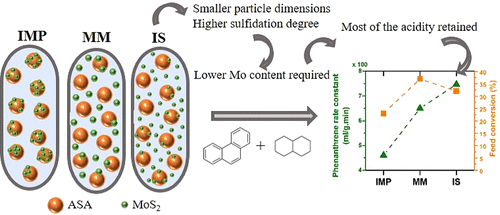当前位置:
X-MOL 学术
›
Energy Fuels
›
论文详情
Our official English website, www.x-mol.net, welcomes your
feedback! (Note: you will need to create a separate account there.)
Bifunctional MoS2-Silica-Alumina Catalysts for Slurry Phase Phenanthrene-Decalin Hydroconversion
Energy & Fuels ( IF 5.2 ) Pub Date : 2018-09-18 00:00:00 , DOI: 10.1021/acs.energyfuels.8b02770 Juliana Sánchez 1 , Andrés Moreno 1 , Fanor Mondragón 1 , Kevin J. Smith 2
Energy & Fuels ( IF 5.2 ) Pub Date : 2018-09-18 00:00:00 , DOI: 10.1021/acs.energyfuels.8b02770 Juliana Sánchez 1 , Andrés Moreno 1 , Fanor Mondragón 1 , Kevin J. Smith 2
Affiliation

|
MoS2-amorphous silica-alumina (MoS2-ASA) bifunctional catalysts for slurry-phase hydroconversion of the model reactants phenanthrene and decalin were prepared using three distinct methodologies. The MoS2-ASA catalysts were prepared by (i) a mechanical mixture of MoS2 (prepared separately) and ASA, which were mixed directly in the reactor for the hydroconversion test (MM catalyst); (ii) in situ sulfidation of the molybdenum precursor in the presence of the ASA, both dispersed in the phenanthrene-decalin reaction mixture (IS catalysts); and (iii) impregnation of molybdenum octoate onto ASA, followed by thermal treatment to chemically link the Mo precursor to the ASA surface followed by sulfidation prior to the catalytic test (IMP catalyst). Among the three preparation methods, the MoS2-ASA catalysts prepared in situ (IS) had the highest MoS2 dispersion and degree of sulfidation and yielded the highest hydrogenating activity at the lowest Mo catalyst content (2.9Mo-ASA). Although the MoS2 blocked Brønsted acid sites decreasing the ASA acidity, especially in IS and IMP catalysts, at the low Mo concentrations required with the IS methodology, most of the acidity was retained. In addition, in the case of IS catalysts, MoS2 particles were also found dispersed in the slurry feed independently of the ASA. Consequently, the IS catalyst retained the advantages of the unsupported MoS2 with the additional functionality of the acid component of the bifunctional catalyst; hence, conversion was promoted due to both hydrogenation and hydrocracking reactions. These observations suggested that the bifunctional MoS2-ASA catalysts prepared in situ promotes hydrocracking reactions at lower temperatures reducing the severity of reaction conditions and limiting coke formation in slurry-phase hydroconversion.
中文翻译:

用于淤浆相菲-萘烷加氢转化的双功能MoS 2-二氧化硅-氧化铝催化剂
使用三种不同的方法制备了用于模型反应物菲和十氢化萘的淤浆相加氢转化的MoS 2-非晶态二氧化硅-氧化铝(MoS 2 -ASA)双功能催化剂。MoS 2 -ASA催化剂是通过(i)MoS 2的机械混合物制备的(分别制备)和ASA,直接在反应器中混合以进行加氢转化测试(MM催化剂);(ii)在ASA存在下将钼前体原位硫化,二者均分散在菲-萘烷反应混合物(IS催化剂)中;(iii)将辛酸钼浸渍到ASA上,然后进行热处理以将Mo前体化学连接到ASA表面,然后在催化试验(IMP催化剂)之前进行硫化。在这三种制备方法中,原位制备的MoS 2 -ASA催化剂(IS)具有最高的MoS 2分散度和硫化度,并且在最低的Mo催化剂含量(2.9Mo-ASA)下具有最高的加氢活性。虽然MoS 2封闭的布朗斯台德酸位降低了ASA的酸度,尤其是在IS和IMP催化剂中,在IS方法要求的低Mo浓度下,大部分酸度得以保留。另外,在IS催化剂的情况下,还发现MoS 2颗粒独立于ASA分散在浆料进料中。因此,IS催化剂保留了无载体MoS 2的优点以及双功能催化剂酸组分的附加功能。因此,由于氢化和加氢裂化反应,促进了转化。这些观察结果表明,双功能MoS 2原位制备的ASA催化剂可在较低温度下促进加氢裂化反应,从而降低反应条件的严重性并限制淤浆相加氢转化中焦炭的形成。
更新日期:2018-09-18
中文翻译:

用于淤浆相菲-萘烷加氢转化的双功能MoS 2-二氧化硅-氧化铝催化剂
使用三种不同的方法制备了用于模型反应物菲和十氢化萘的淤浆相加氢转化的MoS 2-非晶态二氧化硅-氧化铝(MoS 2 -ASA)双功能催化剂。MoS 2 -ASA催化剂是通过(i)MoS 2的机械混合物制备的(分别制备)和ASA,直接在反应器中混合以进行加氢转化测试(MM催化剂);(ii)在ASA存在下将钼前体原位硫化,二者均分散在菲-萘烷反应混合物(IS催化剂)中;(iii)将辛酸钼浸渍到ASA上,然后进行热处理以将Mo前体化学连接到ASA表面,然后在催化试验(IMP催化剂)之前进行硫化。在这三种制备方法中,原位制备的MoS 2 -ASA催化剂(IS)具有最高的MoS 2分散度和硫化度,并且在最低的Mo催化剂含量(2.9Mo-ASA)下具有最高的加氢活性。虽然MoS 2封闭的布朗斯台德酸位降低了ASA的酸度,尤其是在IS和IMP催化剂中,在IS方法要求的低Mo浓度下,大部分酸度得以保留。另外,在IS催化剂的情况下,还发现MoS 2颗粒独立于ASA分散在浆料进料中。因此,IS催化剂保留了无载体MoS 2的优点以及双功能催化剂酸组分的附加功能。因此,由于氢化和加氢裂化反应,促进了转化。这些观察结果表明,双功能MoS 2原位制备的ASA催化剂可在较低温度下促进加氢裂化反应,从而降低反应条件的严重性并限制淤浆相加氢转化中焦炭的形成。











































 京公网安备 11010802027423号
京公网安备 11010802027423号